Cells
All living things are made of cells.
Biology is the science that studies life, and a central principle of Biology is that the cell is the basic unit of life. This means that all living organisms are made of cells. Bacteria, yeast and some other microorganisms consist of a single cell, whereas human beings contain about 100 000 000 000 000 cells.
- What are cells?
- Cells are the building blocks of life. The same way a house is made of lots of bricks stacked together, a living organism is made of lots of cells.
- How do we get from cells to a complex organism like a person?
- Cells stack together to form a tissue (like bricks stack together to form a wall), then tissues organise themselves to form organs (like the heart, muscles or brain). All the organs get organised to form an organism like us.

- Why can't I see my cells?
- Cells are very, very, very small. An animal cell is on average 100 times smaller than a millimeter, or the head of a small pin. So if we could place our cells in a thin row along a fingertip, we would fit about 5000 cells. See how small cells are here
- What are the smallest cells?
- Bacteria are the smallest type of cell. They are often 10 times smaller than an animal cell like our own, and the smallest of the bacteria (mycobacteria) are 10 times smaller than other bacteria (therefore they are 100 times smaller than our cells!).
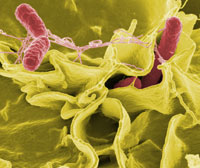
Scanning electron micrograph showing Salmonella bacteria (red) invading human cells. - What are the largest cells?
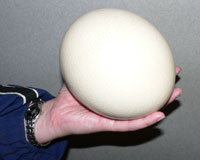 The largest cells are eggs (the cell is the yolk) . The largest cell on the planet today is the ostrich egg yolk, which measures about 20cm!
The largest cells are eggs (the cell is the yolk) . The largest cell on the planet today is the ostrich egg yolk, which measures about 20cm!- How do we know cells exist if we can't see them?
- Scientists in the 17th century invented an instrument that makes objects look bigger – microscopes. The first scientists to see cells were Robert Hooke (England, 1635 -1703) and Antonie van Leeuwenhoek (Netherlands, 1632 - 1723). The term "cell" was introduced by Hooke in his book Micrographia (published in 1665) when he described how cork looked under the microscope; it reminded him of the small rooms monks lived in (called cells).
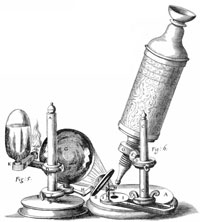
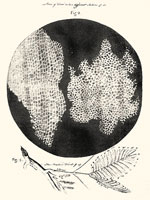
Illustrations from Micrographia (1665) - How do microscopes work?
- Microscopes work like a magnifying glass. A magnifying glass is a special glass lens with a curved shape that makes objects look bigger when we look through it. In other words, it magnifies. Microscopes use special lenses to magnify objects, and there are many types of microscopes with different properties and various degrees of magnification. For example, the compound microscopes used in schools magnify up to 1000 times, and specialised electron microscopes scientists use in their research can magnify up to 500 000 times.
- What do cells look like?
- There are many different types of cells of various sizes and shapes but many share the same backbone and main components. Eukaryotic cells like plant or animal cells contain membrane-bound organelles, which are complex structures with specific functions essential for the cell, much like the organs in our bodies. Bacteria are simpler cells that don't contain organelles - they're prokaryotic cells.
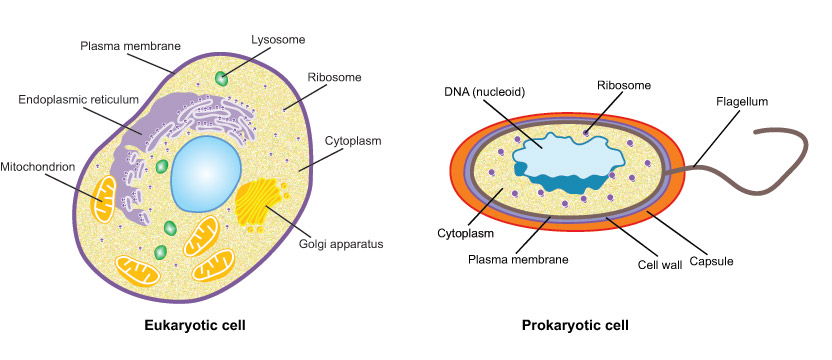
Some features of the cell are shared between eukaryotic and prokaryotic cells.
The plasma membrane is like a bag that holds the contents of the cell and protects it from the outside - similar to our skin. Everything inside cells is immersed in a salty liquid called cytoplasm.
Ribosomes are like factories that make a variety of important molecules called proteins.
The cytoskeleton, like the name suggests, gives the cell shape and rigidity. In eukaryotes, the cytoskeleton also acts like a railway network along which molecules and organelles are transported.Some organelles are found specifically in eukaryotes:
The nucleus: this is the compartment that contains the DNA (deoxyribonucleic acid) in a eukaryotic cell. DNA is the molecule that makes genes, which contain the information to make the organism and to ensure the cell does its job (bacteria don't have a nucleus – their DNA is in the cytoplasm).
Mitochondria: these organelles generate energy for the cell.
The endoplasmic reticulum is where many proteins and other molecules in the cell are made.
Lysosomes are the recycling centres of cells, they destroy the molecules that are defective or no longer needed.
The Golgi apparatus packages and prepares the molecules that leave the endoplasmic reticulum to be send to different parts in the cells, like a post office where letters are packaged and labeled to be sent to their destinations. - Why do cells look so different?
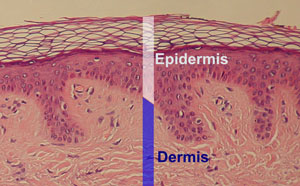
Histological image of human skin epidermis.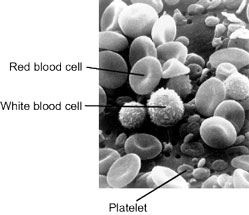 Cells have many jobs. One person has more than 250 different types of cells doing very specialised things. For instance, in our blood we have both red blood cells that carry the oxygen from our lungs to all the other cells in the body, and white blood cells which seek out and destroy invaders like bacteria or viruses.
Cells have many jobs. One person has more than 250 different types of cells doing very specialised things. For instance, in our blood we have both red blood cells that carry the oxygen from our lungs to all the other cells in the body, and white blood cells which seek out and destroy invaders like bacteria or viruses.
In the skin we have epidermal cells, which are very wide and flat and stack together very tightly forming a barrier to protect us from the outside world.
- Why do scientists study cells?
- One reason is that scientists are very curious people and they like to understand how things work. What drives many scientists is that they think it's important to increase our knowledge of the universe. But probably the most important reason scientists study cells is because cells that don't work properly lead to disease. For instance, diseases like cancer, Alzheimers, Parkinsons, diabetes and others, result from cells that are malfunctioning. So scientists all around the world are working very hard to understand how cells work, and what goes wrong in our cells when we become ill. When scientists find out how cells function and what goes wrong with them during disease, they can then use the information to try to find new treatments.

